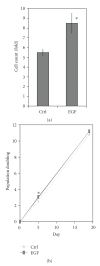Epidermal growth factor (EGF) treatment on multipotential stromal cells (MSCs). Possible enhancement of therapeutic potential of MSC
- PMID: 20182548
- PMCID: PMC2825653
- DOI: 10.1155/2010/795385
Epidermal growth factor (EGF) treatment on multipotential stromal cells (MSCs). Possible enhancement of therapeutic potential of MSC
Abstract
Adult bone marrow multipotential stromal cells (MSCs) hold great promise in regenerative medicine and tissue engineering. However, due to their low numbers upon harvesting, MSCs need to be expanded in vitro without biasing future differentiation for optimal utility. In this concept paper, we focus on the potential use of epidermal growth factor (EGF), prototypal growth factor for enhancing the harvesting and/or differentiation of MSCs. Soluble EGF was shown to augment MSC proliferation while preserving early progenitors within MSC population, and thus did not induce differentiation. However, tethered form of EGF was shown to promote osteogenic differentiation. Soluble EGF was also shown to increase paracrine secretions including VEGF and HGF from MSC. Thus, soluble EGF can be used not only to expand MSC in vitro, but also to enhance paracrine secretion through drug-releasing MSC-encapsulated scaffolds in vivo. Tethered EGF can also be utilized to direct MSC towards osteogenic lineage both in vitro and in vivo.
Figures






Similar articles
-
Sustained epidermal growth factor receptor levels and activation by tethered ligand binding enhances osteogenic differentiation of multi-potent marrow stromal cells.J Cell Physiol. 2009 Nov;221(2):306-17. doi: 10.1002/jcp.21854. J Cell Physiol. 2009. PMID: 19544388 Free PMC article.
-
Cross-talk between EGF and BMP9 signalling pathways regulates the osteogenic differentiation of mesenchymal stem cells.J Cell Mol Med. 2013 Sep;17(9):1160-72. doi: 10.1111/jcmm.12097. Epub 2013 Jul 11. J Cell Mol Med. 2013. PMID: 23844832 Free PMC article.
-
Surface tethered epidermal growth factor protects proliferating and differentiating multipotential stromal cells from FasL-induced apoptosis.Stem Cells. 2013 Jan;31(1):104-16. doi: 10.1002/stem.1215. Stem Cells. 2013. PMID: 22948863 Free PMC article.
-
The therapeutic applications of multipotential mesenchymal/stromal stem cells in skeletal tissue repair.J Cell Physiol. 2009 Feb;218(2):237-45. doi: 10.1002/jcp.21592. J Cell Physiol. 2009. PMID: 18792913 Review.
-
The origins of mesenchymal stromal cell heterogeneity.Stem Cell Rev Rep. 2011 Sep;7(3):560-8. doi: 10.1007/s12015-011-9229-7. Stem Cell Rev Rep. 2011. PMID: 21437576 Review.
Cited by
-
Mesenchymal stem cells exploit extracellular matrix as mechanotransducer.Sci Rep. 2013;3:2425. doi: 10.1038/srep02425. Sci Rep. 2013. PMID: 23939587 Free PMC article.
-
Renal cancer secretome induces migration of mesenchymal stromal cells.Stem Cell Res Ther. 2023 Aug 10;14(1):200. doi: 10.1186/s13287-023-03430-4. Stem Cell Res Ther. 2023. PMID: 37563650 Free PMC article.
-
Optimization of culture condition of human bone marrow stromal cells in terms of purification, proliferation, and pluripotency.In Vitro Cell Dev Biol Anim. 2014 Oct;50(9):822-30. doi: 10.1007/s11626-014-9778-6. Epub 2014 Jun 17. In Vitro Cell Dev Biol Anim. 2014. PMID: 24934232
-
Avoidance of Maternal Cell Contamination and Overgrowth in Isolating Fetal Chorionic Villi Mesenchymal Stem Cells from Human Term Placenta.Stem Cells Transl Med. 2017 Apr;6(4):1070-1084. doi: 10.1002/sctm.15-0327. Epub 2017 Feb 16. Stem Cells Transl Med. 2017. PMID: 28205414 Free PMC article.
-
Epidermal Growth Factor Tethered to β-Tricalcium Phosphate Bone Scaffolds via a High-Affinity Binding Peptide Enhances Survival of Human Mesenchymal Stem Cells/Multipotent Stromal Cells in an Immune-Competent Parafascial Implantation Assay in Mice.Stem Cells Transl Med. 2016 Nov;5(11):1580-1586. doi: 10.5966/sctm.2015-0326. Epub 2016 Jul 8. Stem Cells Transl Med. 2016. PMID: 27400798 Free PMC article.
References
-
- Barry FP, Murphy JM. Mesenchymal stem cells: clinical applications and biological characterization. International Journal of Biochemistry and Cell Biology. 2004;36(4):568–584. - PubMed
-
- Phinney DG, Prockop DJ. Concise review: mesenchymal stem/multipotent stromal cells: the state of transdifferentiation and modes of tissue repair—current views. Stem Cells. 2007;25(11):2896–2902. - PubMed
-
- Tamama K, Fan VH, Griffith LG, Blair HC, Wells A. Epidermal growth factor as a candidate for ex vivo expansion of bone marrow-derived mesenchymal stem cells. Stem Cells. 2006;24(3):686–695. - PubMed
-
- Prockop DJ. Marrow stromal cells as stem cells for nonhematopoietic tissues. Science. 1997;276(5309):71–74. - PubMed
-
- Pittenger MF, Mackay AM, Beck SC, et al. Multilineage potential of adult human mesenchymal stem cells. Science. 1999;284(5411):143–147. - PubMed
Publication types
MeSH terms
Substances
Grants and funding
LinkOut - more resources
Full Text Sources
Other Literature Sources

